Written by: Lucas Tcheyan, Research Assistant at Galaxy Digital
Translated by: Jinse Finance xiaozou
Starting from July 16, ETH unstaking requests dramatically increased, with validator exit requests surging from 1,920 to over 475,000 by July 22, and waiting times extending from less than an hour to over eight days. Although ETH's recent price performance and the ETH Pectra upgrade's adjustments to validator staking requirements are expected to increase unstaking activities, this surge was primarily driven by the sharp rise in ETH lending rates starting July 16. The rate spike triggered widespread ETH cyclic strategy liquidations, further intensifying the de-pegging pressure on ETH-based liquid staking and restaking tokens (LSTs and LRTs).
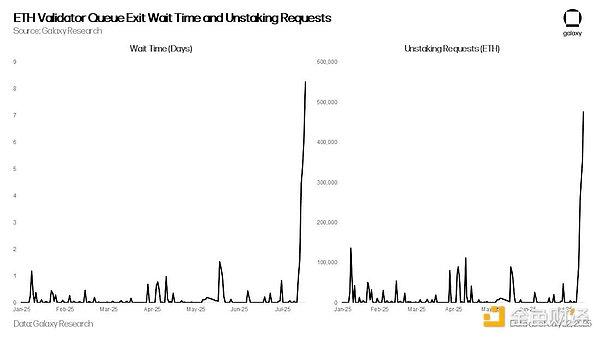
1. Ethereum Staking Queue
Ethereum's staking exit queue is an inherent mechanism designed to manage validators' orderly withdrawal of staked funds from the network. To maintain network stability and prevent massive validator exits from compromising consensus, Ethereum limits the number of validators that can exit per epoch. This limit, known as the "churn limit," is related to the total number of active validators, allowing approximately 8 to 10 validators to exit per epoch (about 6.4 minutes). When validators initiate voluntary exits, they enter a queue and wait for processing. After exiting, funds undergo a mandatory delay (around 27 hours) before becoming withdrawable. During periods of high exit demand, the queue can become severely backlogged, resulting in waiting times spanning days or even weeks.
This is not the first time Ethereum has experienced an unstaking backlog. In January 2024, when the bankrupt crypto lending platform Celsius needed to withdraw 550,000 ETH during its restructuring, the waiting queue reached six days.
2. ETH Cyclic Strategy Liquidation Wave: Lending Rate Surge Triggers Chain Reaction
Since July 14, ETH lending rates in the Aave decentralized finance protocol began cyclically spiking. While lending rates typically remain between 2% and 3%, they surged to highs of 18% on July 16, 18, and 21. This dramatic volatility stemmed from massive withdrawals by HTX exchange-related wallets, causing a sharp reduction in Aave platform's ETH supply. This wallet has accumulated over 167,000 ETH withdrawals since June 18, and the sudden decrease in available deposits put pressure on users running ETH cyclic strategies on Aave, partly contributing to the surge in unstaking requests.
Cyclic strategies are widely adopted by crypto traders to amplify ETH staking yields. The standard procedure involves users depositing liquid staking tokens (LST) or liquid restaking tokens (LRT) as collateral on platforms like Aave, borrowing ETH, converting it to more LST for re-deposit, and repeatedly establishing leveraged positions. When staking yields exceed ETH lending rates, users can profit from the interest spread. This strategy can be manually executed or automated through vaults provided by protocols like EtherFi and Instadapp.
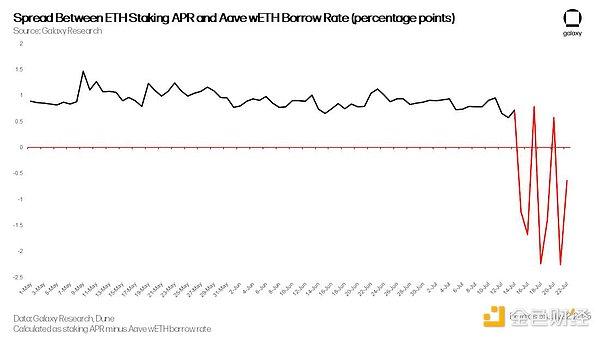
However, with ETH supply tightening from July 16, the interest spread between staking yields and borrowing costs turned negative.
By July 21, this spread dropped to a low of -2.25%, rendering cyclic strategies unprofitable. This triggered massive liquidations, with users withdrawing deposited ETH, repaying loans, and gradually reducing leverage. Since most traders use LST/LRT as collateral, they needed to convert these assets back to ETH or unstake, adding additional pressure to the LST/LRT secondary market and Ethereum validator exit queue.
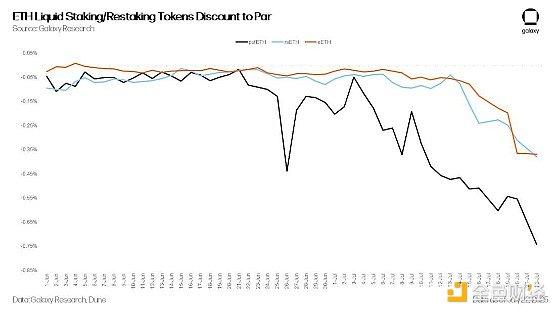
As lending rates rose, de-pegging of LST and LRT from ETH further intensified. Typically, LST/LRT maintains a slight discount relative to ETH to compensate for redemption delays, DEX liquidity limitations, and protocol-specific risks. During forced deleveraging or redemption, this selling pressure pushes LST/LRT prices further below par. Additionally, automated cyclic strategy vaults responded differently to market fluctuations—some chose to unstake, while others directly sold on secondary markets. Currently, EtherFi's liquidity strategy still has around 20,000 ETH in Ethereum's exit queue.
Another factor exacerbating queue congestion is that some market participants began arbitraging LST/LRT de-pegging. By purchasing discounted LST/LRT in secondary markets and redeeming full ETH value through unstaking, they can profit from the price difference. This further increases ETH exit queue requests.
3. Simultaneous Surge in New Staking Demand
Counterbalancing the unstaking request surge is a significant uptick in new staking demand. Since June, ETH staking applications and validator admission requests have climbed to their highest levels since April 2024.
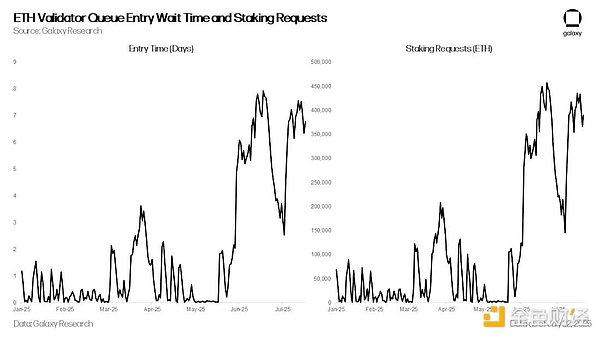
This is primarily driven by two factors: first, ETH's superior performance relative to Bitcoin reigniting market enthusiasm;
second, recent acquisitions of over $2.5 billion in ETH by multiple digital asset treasury companies (DATCOs).
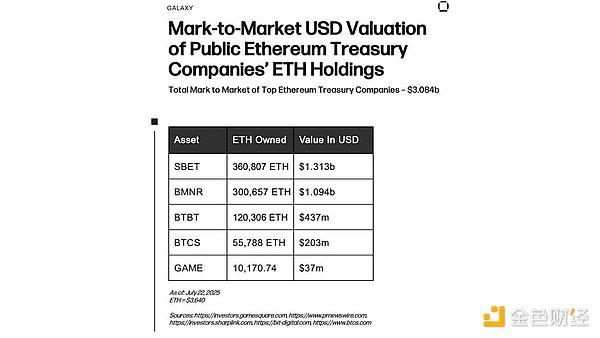
4. Future Outlook
Although headlines about ETH unstaking might initially suggest a profit-taking wave, a deeper examination reveals that most activity is driven by ETH lending market volatility and lending rate spikes since July 16. This is substantiated by the still-strong new staking demand—new staking volumes nearly offset current withdrawal scales.
Despite the demand surge, ETH's staking architecture continues to operate as expected. While some might complain about significantly extended waiting times, this is precisely a network design feature, not a flaw. Its purpose is to limit validator entry and exit rates, thereby protecting the stability and security of Ethereum's Proof of Stake (PoS) consensus mechanism.
However, this event highlights the ongoing fragility of the ETH liquid staking and restaking ecosystem. These assets remain highly sensitive to leverage strategies and are vulnerable under extreme market conditions. The widespread impact of LST/LRT de-pegging and redemption delays further emphasizes the importance of considering duration risk and liquidity bottlenecks.
Looking forward, protocols entirely dependent on Ethereum's native exit mechanisms may face more stringent scrutiny. We anticipate increased market focus on solutions enhancing redemption flexibility—such as peer-to-peer exit markets, optimized LST/LRT automated market makers (AMMs), and protocol-native liquidity vaults specifically designed to mitigate exit queue congestion and smooth fund flows.







